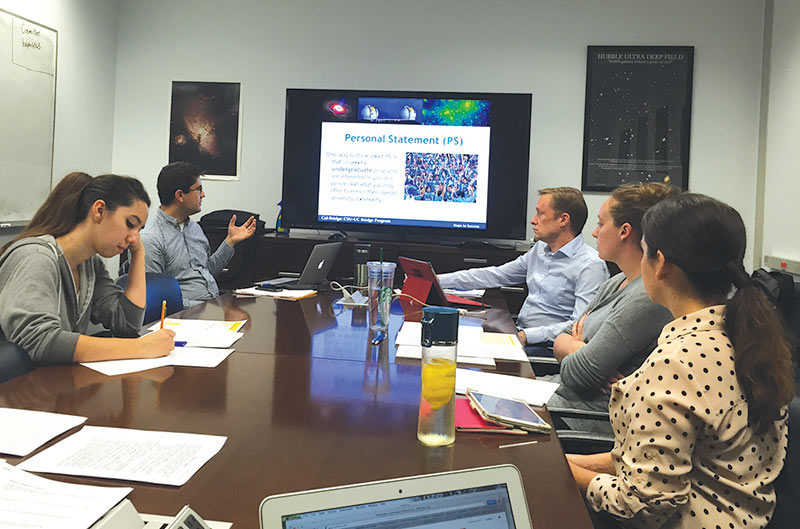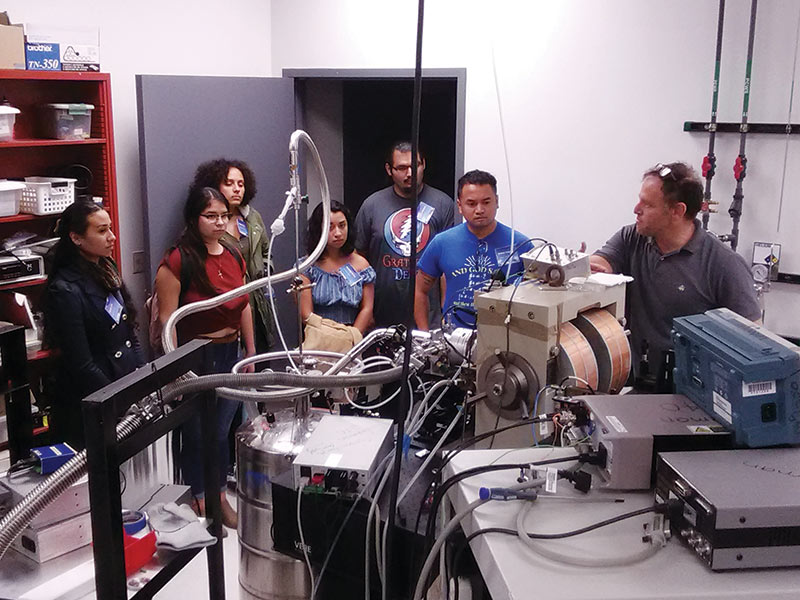Better Science Through Diversity
Fall
2019
Feature
Better Science Through Diversity
Cal-Bridge draws high-potential students into PhD programs in physics and astronomy
By:Korena Di Roma Howley, Contributing Editor
In the winter of 2018, Dennis Calderon had recently returned to school after a three-year absence when he attended a seminar led by Dr. Amy Furniss, an assistant professor of physics at California State University, East Bay. Fascinated by the topic of the talk—an overview of Furniss’s work on very-high-energy gamma rays that come from blazars—Calderon approached Furniss about joining her group. Two years later, he’s set to begin a PhD program at The Ohio State University, where he’ll continue astroparticle physics research while transitioning into the study of neutrinos.
Though Calderon had always been interested in physics, previous college studies had been disrupted by work commitments, a long commute, and financial difficulties. After leaving school, he hadn’t planned to go back. While Furniss’s seminar had rekindled his interest in physics, to see where that interest could take him, Calderon needed the kind of support he had previously lacked—and that’s where Cal-Bridge came in.
“I almost can’t even describe how amazing the program has been,” he says. “I wouldn’t be where I am today without Cal-Bridge.”
Bridging the Gap
Founded in 2014 by Alexander Rudolph, professor of physics and astronomy at Cal Poly Pomona, the Cal-Bridge program supports students along their physics journey while increasing diversity in the field. Modeled in part after the Fisk-Vanderbilt Master’s-to-PhD Bridge Program and funded by the National Science Foundation, Cal-Bridge provides full scholarships, mentorships, and professional development and research opportunities to undergraduate students from groups traditionally underrepresented in physics.
The bridge takes students from the California State University (CSU) system—which offers few doctoral programs—to the PhD programs in physics and astronomy available in the University of California (UC) system, though since the start of Cal-Bridge, students have also been accepted into and attended doctoral programs elsewhere.
Rudolph knew, based on the diversity of the CSU system and its 23 campuses, that the program would have a broad pool of talent to draw from. “I don’t believe that the ability to be a successful physicist or astronomer is related to gender or race or ethnicity in any way,” he says.
Both the students and the field as a whole benefit from a more representative community of scientists. “Most science now is done in teams,” Rudolph says. “The image we have in our heads is the lone scientist in his lab—and it’s usually a he … Albert Einstein at his desk, Enrico Fermi in the lab. But in reality, almost everything we do in science nowadays is in teams.”
And, he says, there’s evidence that teams with members who have different perspectives—who come from different parts of society and have different backgrounds—are more productive. “Our field should reflect society, and I think we’ll do better science if we get more people involved and have a more diverse population,” he says.
What Rudolph calls a “holistic selection process” for choosing Cal-Bridge scholars involves looking at a number of characteristics that correlate with success, including academic potential. “We don’t just look at the grades they have, but what we believe they can do,” he says. “We also look for evidence of leadership ability, communication skills, and the ability to have long-term goals.”
And the process takes into account the fact that women and minority students in physics face additional barriers and challenges. “Have they faced a lot of obstacles? is one thing we look at,” Rudolph says, “and the other is, How well do they overcome them?” The latter, he explains, reveals the grit and persistence it can take to succeed.
When medical issues forced her to withdraw for a semester from her undergraduate studies in astrophysics at San Francisco State University, Imani Ware remained determined to pursue her lifelong dream of becoming an aerospace engineer. She found support through her Cal-Bridge mentors, who helped her communicate with professors, obtain missed study material, and focus on her health and well-being. “They were there for me when I needed them and have given me the opportunity to return to my studies stronger than before,” she says.
For Cristilyn Gardner, now a PhD candidate studying exoplanets at the University of Wyoming, Cal-Bridge removed financial and other pressures, making it possible for her to accept internships and attend workshops, conferences, and a summer research program. “[Cal-Bridge] gave me confidence,” she says. “It put me in the mindset that I could achieve great things.”
The CAMPARE Difference
Two programs fall under the Cal-Bridge umbrella. The first is a partnership between the UC and CSU systems and more than 30 community colleges across the state. Cal-Bridge Scholars that transfer from a community college to a CSU and those recruited directly from CSUs, benefit from mentoring by faculty and research programs at UC and other campuses.
The other program, founded by Rudolph in 2009, is the California Minority Partnership for Astronomy Research and Education, or CAMPARE, which sends students from CSU and California community college campuses to summer research programs in physics, astronomy, astrobiology, and planetary science all over the country.
“Research experience has been shown to help motivate students to go on to get PhDs,” Rudolph says. In fact, of the students who have participated in CAMPARE and earned a bachelor’s degree, 65 percent pursued graduate studies in related fields.
Evan Nuñez is a Cal-Bridge scholar and physics major who recently graduated from Cal Poly Pomona and will be starting an astrophysics PhD program at Caltech this fall. Nuñez attended the University of Wyoming’s research program through CAMPARE, and while there, he says, he was able to live the astronomer’s dream—driving up to a telescope, taking data all night, sleeping through the evening, reducing the data, and then restarting the process all over again. “It turns out that I loved every single part of the experience,” he says, “even the tedious and difficult moments, which was a sign to me that I was going down the right path.”
Paying It Forward
Cal-Bridge participants also make it clear that the program has been, for them, about more than academics. It has fostered a sense of community among and between each year’s cohort of scholars (up to 25 in past years). The existing students help the incoming class, which then does the same for those coming up behind them. And the impulse to pay it forward doesn’t end there.
Driven by their own experiences, Calderon, Gardner, and Nuñez all cited the dual UC and CSU mentorships as a highlight of the program. Each expressed a strong desire to mentor others, not just as time allows but as a focal point of their future careers.
“I want to go into academia—that’s always been a dream of mine,” says Calderon, who’ll be attending Ohio State through its own MS-to-PhD bridge program. But the biggest reason to teach, he says, is to follow in Furniss’s footsteps. “I want to do this for another student,” he says.
According to Nuñez, the mentoring Cal-Bridge provided reminded him that he wasn’t alone. “I always had [someone] I could talk to about how my classes were going, how my research was going, how I was coping with my transition as a transfer student,” he says. And looking toward a career as a research professor or staff scientist, Nuñez says he plans on returning the favor to future students.
Gardner says she feels passionate about the continuation of the program and the role she can play in mentoring others. “I really want to be [in] STEM outreach and mentoring younger kids and even undergraduates,” she says. “If I end up as a faculty member or research scientist…I still want to have some part in that.”
Because the program began in 2014 and participants enter as juniors, none of the Cal-Bridge scholars have yet completed a PhD program. But, says Rudolph, the 80 percent success rate they’ve had for getting into doctoral programs already far surpasses the typical CSU rate, and the quality of the programs is much higher.
“We don’t yet know about the long-term effect,” he says. “But I do have a lot of confidence that we’re going to have a big impact.” 


